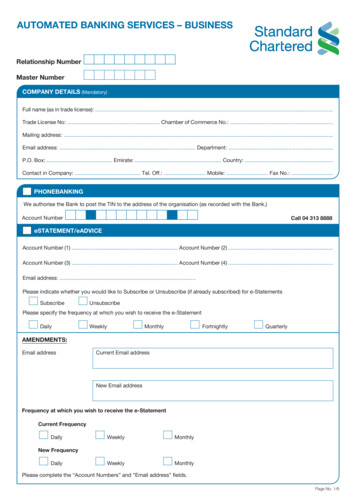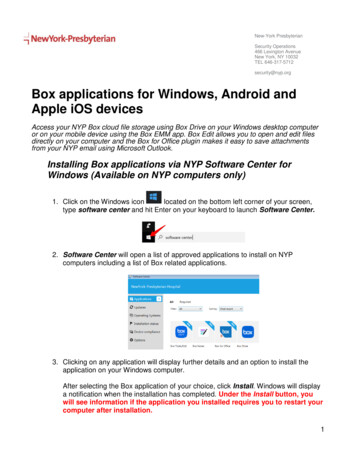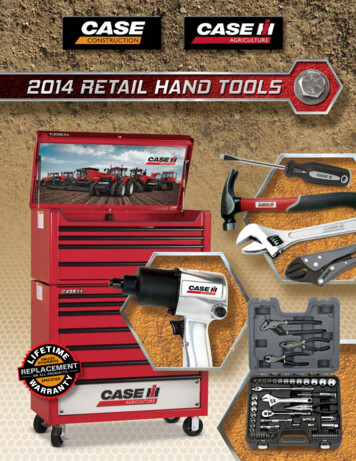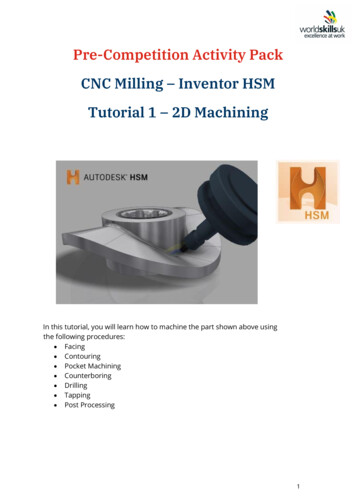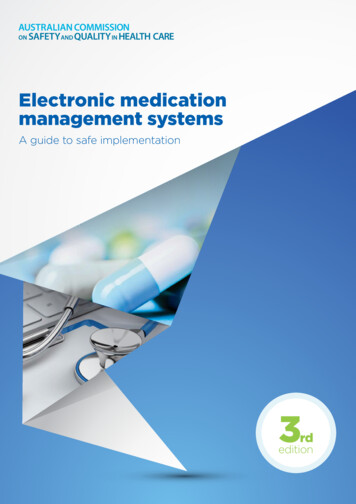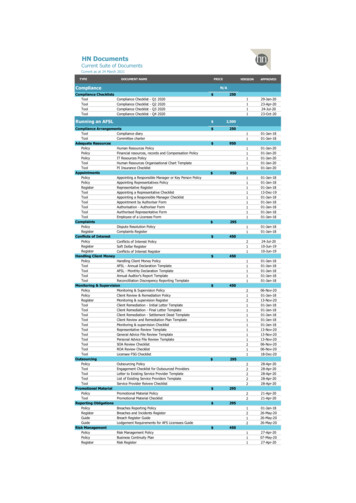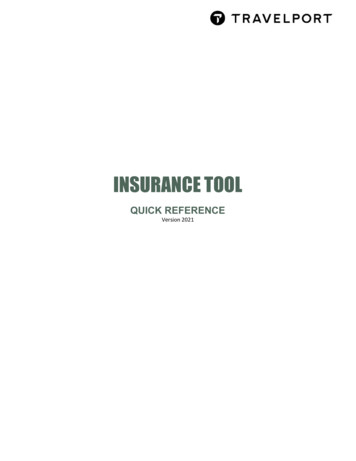
Transcription
TOOL BOX TALKS:A YEAR’S WORTH OF WEEKLY SAFETY MEETING SUBJECTSTable of ContentsPages 1-3Introduction – Why This Project?Pages 4-5Safety TrainingPages 6-17Whose Responsibility Is It?Supplemental InformationThe Deadly DozenWhy Accidents OccurRecognizing Unsafe ConditionsShop SafetyWhat Does An Accident CostNear MissesCare For The InjuredAccidents Are AvoidableListen For DangerAccident/Incident ReportingSample Report FormPage 6Pages 6A and 6BPage 7Page 8Page 9Page 10Page 11Page 12Page 13Page 14Page 15Page 16Page 17Common Sense SubjectsPages 18-23Safety Is Common SenseKeeping In ShapeWarming UpProper LiftingHorseplayShort CutsPage 18Page 19Page 20Page 21Page 22Page 23Protecting the PublicPages 24-28Protecting the PublicChildren And ConstructionVehicle OperationsTraffic ControlBarricades & Warning DevicesPage 24Page 25Page 26Page 27Page 28Effects of WeatherPages 29-31Effects of WeatherHeat Exhaustion/SunstrokeDressing for Winter WorkPage 29Page 30Page 31Personal Protective EquipmentPages 32-39Construction ClothingHead Protection -- Hard HatsEye ProtectionFoot ProtectionHand ProtectionPersonal Protective Equipment – Concrete ConstructionKnee PadsRespiratorsPage 32Page 33Page 34Page 35Page 36Page 37Page 38Page 39
Table of Contents, Continued:Page 2HousekeepingPages 40-45HousekeepingTrash ChutesMaterial StorageMaterial HandlingThe SpotterSignaling TechniquesPage 40Page 41Page 42Page 43Page 44Page 45Tool Use and CarePages 46 - 57The Right Tool For The Right JobHand ToolsScrewdriversWrenchesHammers/ChiselsNails Are Dangerous TooTable SawsElectric Power ToolsElectric Hand SawsPortable Electric ToolsPowder Actuated ToolsChain SawsPage 46Page 47Page 48Page 49Page 50Page 51Page 52Page 53Page 54Page 55Page 56Page 57JOB SITE HAZARDS – THE BIG FOURWhat Are The Big Four?Training Requirements - Fall HazardsPage 58Page 59Falls From Elevated HeightsPages 60-65FallsLaddersFall Causes Death: Ladders Are KillersFloors and Other OpeningsGuardrailsRamps and RunwaysFull Body Harnesses/LifelinesPage 60Page 61Page 61APage 62Page 63Page 64Page 65Being Struck By (Comments on the Subject)Page 66Being Caught Between or UnderPages 67 - 74ExcavationsExcavation: Additional Discussion PointsTrenchingDangers OverheadWorking in Confined SpacesHeavy EquipmentHeavy Equipment HazardsWorking Around CranesPage 67Page 68Page 69Page 70Page 71Page 72Page 73Page 74
Table of Contents, Continued:Page 3ElectricalPages 75-77Electrical HazardsAssured Grounding ProgramPower Lines and Mobile CranesPage 75Page 76Page 77Fire ProtectionPages 78-81Fire Protection and ControlFire ExtinguishersRefueling EquipmentGasolinePage 78Page 79Page 80Page 81Safety Away From WorkCompressed Gas CylindersPage 82Page 83ResourcesQuick Reference GuideAccident Prevention Signs and TagsConstruction Safety Training & EducationElectricalExcavationsFall ProtectionHand & Power ToolsHazard CommunicationsNoise ExposurePermit-Required Confined SpacesPersonal Protective Equipment (PPE)Respirator ProtectionSafety CommitteesSite ClearingStairways & Ladders in ConstructionWoodworking Machinery(pending)Periodic Training and/or CertificationPages 84-90(P. 84)(P. 84)(P. 84)(P. 85)(P. 85)(P. 86)(P. 86)(P. 87)(P. 88)(P. 89)(P. 89)(P. 90)(P. 90)(P. 90)(P. 90)(P. 91-95)“Tool Box Talk” Training RecordPage 96-98Safety Training StepsBlank Training OutlinePage 99Page 100
Page 4TOOL BOX TALKSIntroduction: Why This Project?WHY TRAINING?An insightful contractor commented that if everyone used their common sense, we wouldn’t haveinjuries or accidents on or off the job. Workers need to be trained in the recognition andavoidance of unsafe conditions as part of company profitability and professional development.Using common sense is only part of the solution in preventing injuries or accidents.Safety CommitteeThere is a Safety Committee factor involved in training. Employers in the construction trades arerequired to have a Safety Committee. A purpose of a Safety Committee is to identify hazards inthe workplace (generally through quarterly inspections) and “make recommendations to theemployer regarding corrections of the hazards.” A second purpose is to “establish procedures forinvestigating all safety-related incidents ” Topics in this document are intended to help in having aviable Safety Committee by providing a quick reference guide to build on to accomplish boththese important tasks.SELECTING TOPIC’SUse common sense in selecting a topic. You wouldn’t want to present “Dressing For WinterWork” at the start of summer. “Heat Exhaustion/Sunstroke” is more appropriate to the season.Failure on your part to select an appropriate topic to present will result in uninterested workers, awaste of everyone’s time and a loss of creditability on the part of company management.Observe job-safety techniques. Focus on what is important (and mandatory). Listen to and followup on company Safety Committee and employee recommendations. Identify what poor workpractices are causing injuries or accidents on the job. Plan for and schedule out for a month soyou have time to research and possibly modify your company policy.INSTRUCTION GUIDEEach of the “tool box talks” has an introductory statement, a guide for discussion, and spacefor additional discussion notes. Some have some reminders for the instructor on subjects toresearch and discuss; others require knowing company policy. We recommend employeessigning the page; the company then maintains the topic as a record on file.Training RecordsIn selected situations, you should have and maintain an individual training record on eachemployee. Included is Competent Person training for employee’s using ladders and stairways,to recognize and minimize fall hazards and actions to take in fall protection. These arecompliance actions as well as “common sense” to protect the contractor. See the ReferenceSection for more information on mandatory training subjects.
Page 5CUSTOMIZINGThe following are some of the talks that require some sort of company specific information:Page 9Page 13Page 15Page 16Page 19Page 24Page 29Page 32Page 33Page 35Page 39Page 50Page 53Page 57Page 65Page 73Page 75Page 76Page 78Page 79Recognizing Unsafe ConditionsCare For The InjuredListening SafetyAccident/Incident ReportingKeeping In ShapeProtecting the PublicEffects of WeatherConstruction ClothingHead Protection – Hard HatsFoot ProtectionRespiratorsHammers/ChiselsPortable Electric ToolsChain SawsFull Body Harnesses/LifelinesHeavy Equipment HazardsElectrical HazardsAssured Grounding ProgramFire Protection and ControlFire ExtinguishersRequires specific name(s)Requires 1st Aid informationAddress policy issueRequires specific namesAddress policy issueAddress policy issueAddress policy issueAddress policy issueAddress policy issueAddress policy issueAddress policy issuesAddress policy issueAddress policy issuesAddress policy issues (PPE)Address policy issuesRequires specific namesAddress policy issueAddress location issueAddress location/policy issueRequires specific namesDESIGNING YOUR OWNWhen you design your own specialized tool box talks, remember some basic principals in givinginstruction: Introduce what you are going to explain them, the body or key points you want tocover, and a conclusion. Ask for questions. Conclude with a reminder; the key point you tried toget across in the first place.Supervisor TrainingThe importance of training supervisors in their responsibilities is an important managementfunction as well as lawfully required when others are placed in charge of workers. They know themost about the people they work with daily, the equipment, materials and environment becauseof first-line supervisory responsibilities. Therefore it makes sense to train supervisors and is whythe two are separated into the two subjects.
Page 6Whose Responsibility Is It?After an accident has occurred, it is not unusual for those who were around the injured worker tofeel guilty. This guilt is part of each person’s inner awareness that there was possibly somethingthey could or should have done to prevent the accident. Sometimes the accident is the result ofsomeone else’s mistakes. But who causes the accident is not as important as who is responsiblefor the accident, and what steps will be taken to correct future similar accidents from happening.The following is a partial list of responsibilities for safety on the job.Guide for DiscussionWho’s Responsible? (Discussion Points)Senior company management?Crew supervisor?Each person on the job?Trained safety professionals?Company safety committee?Some Responsibility Rules for EveryoneIf it’s unsafe for you then it’s unsafe for the next person and the hazard should becorrected.Safety doesn’t belong to any one construction craft; rather it is part of every constructioncraft to be responsible.If safety doesn’t begin with you, it won’t begin at all.An Individual’s ResponsibilityTo yourselfTo your familyTo your co-workersTo your companyAdditional Discussion Notes: (See Pages 6A and 6B)Remember: Workers’ compensation checks won’t pay all the bills nor will they replace the selfesteem one has from being a good provider to their families. Without complete cooperation fromeveryone on the worksite, it just will not be as safe as it should be.Attendees:NOTE: Always promote a discussion on any of the topics covered in the Tool Box Talks. Shouldany question arise that you cannot answer, don’t hesitate to contact your Employer.
Page 6ASupplemental Information ForWhose Responsibility Is ItA Tool Box TalkInstructor Note: This written test can be given to employees, supervisors, the employer and thecompany safety committee to reinforce training in “Whose Responsibility Is It.” An answer sheetand a discussion topic is found on page 6B.In our company, who is primarily responsible for the following safety activities?ESCSEMP Employee Safety Committee Supervisor EmployerComplying with Safety RulesConducting Safety TrainingRecognizing Others for Safety Performances (Good or Bad)Reporting Injuries or IllnessesProviding Feedback About Safe Work ProceduresEnforcing Safety RulesConducting Area Safety InspectionsSelecting Personal Protective Equipment (PPE)Assessing Workplace HazardsReporting HazardsConducting Accident InvestigationsRewarding IncentivesRecommending Corrective Actions to Eliminate HazardsDemonstrating Safe Work PracticesTraining Safe Work Procedures to New EmployeesEnsuring Safe and Healthful Work AreasMonitoring Safety and Health ProgramsShowing Others How to Use Personal Protective EquipmentReporting Incidents or Near MissesEliminating or Reducing HazardsDeveloping Safe Work ProceduresConducting Job Hazard Analyses
Page 6BSupplemental Information For: Whose Responsibility Is It, ContinuedAnswer SheetChoicesESCSEMP Employee Safety Committee Supervisor EmployerBecause each company is different, there are no single correct answers. However, oneperspective of primary responsibility recommends one of the following answers:E, SC, S, EMPSC, S, EMPSC, S, EMPE, SE, SCSC, S, EMPSC, S, EMPSC, EMPSC, EMPSCSC, S, EMPSC, EMPE, SC, SSC, S, EMPSC, S, EMPSC, S, EMPSC, S, EMPSC, S, EMPE, SE, SC, S, EMPSC, S, EMPS, EMPComplying with Safety RulesConducting Safety TrainingRecognizing Others for Safety Performances (Good or Bad)Reporting Injuries or IllnessesProviding Feedback About Safe Work ProceduresEnforcing Safety RulesConducting Area Safety InspectionsSelecting Personal Protective Equipment (PPE)Assessing Workplace HazardsReporting HazardsConducting Accident InvestigationsReward IncentivesRecommending Corrective Actions to Eliminate HazardsDemonstrating Safe Work PracticesTraining Safe Work Procedures to New EmployeesEnsuring Safe and Healthful Work AreasMonitoring Safety and Health ProgramsShowing Others How to Use Personal Protective EquipmentReporting Incidents or Near MissesEliminating or Reducing HazardsDeveloping Safe Work ProceduresConducting Job Hazard AnalysesWhy such emphasis on Supervisors?WAC 296-800-14020The employer shall instruct each employee in the recognition and avoidance of unsafe conditionsand the regulations applicable to his/her work environment to control or eliminate any hazards orother exposure to illness or injury.Past WISHA rulings have indicated that:“Any supervisor or persons in charge of work are held to be agents of the employer in thedischarge of their authorized duties.”Authorized duties include:(a) The execution in a safe manner of the work under their supervision;(b) The safe conduct of their crew while under their supervision; and(c) The safety of all workers under their supervision.”It makes good sense to hold supervisors responsible for the employees placed under theircharge. It builds a sense of teamwork and shared responsibility for safe productivity.Supervisors are generally closer to the employees under their charge and better able to positivelyinfluence positive behavioral change.
Page 7The Deadly DozenWe all know that there must be a cause for an accident to happen. In order to avoid accidents,we must remove the cause. Every cause is a result of an unsafe act or unsafe condition. Byrecognizing the unsafe act or condition, we can effectively remove the exposure to them. Thefollowing “deadly dozen” are reminders to help you recognize unsafe acts or conditions.Guide for DiscussionUnsafe Acts1.2.3.4.5.6.7.8.9.10.11.12.Unauthorized use or operation of equipment.Failure to secure or tie down materials to prevent unexpected movement.Working or operating equipment too fast.Failure to issue warnings or signals as required.Using defective tools or equipment.Removing guards.Improperly using tools or equipment.Standing in an unsafe place or assuming an improper posture (as in lifting).Servicing moving equipment.Riding equipment not designed for passengers.Horseplay.Failure to wear the proper personal protective equipment.Unsafe Conditions1.2.3.4.5.6.7.8.9.10.11.12.Lack of proper guards.Lack of a proper warning system.Fire and explosion hazards.Poor housekeeping.Unexpected movements.Protruding objects such as nails, wire, or other metals.Improper clearance or congestion at aisles or passageways.Poor placement, storage or arrangement of materials.Hazardous tools, equipment or materials.Poor lighting, high noise levels.Hazardous atmospheric conditions.Improper personal attire.Additional Discussion Notes:Remember: Be able to recognize the conditions or acts we just discussed, you can effectivelycorrect or avoid them and reduce your personal exposure to the general causes of accidents.Attendees:NOTE: Always promote a discussion on any of the topics covered in the Tool Box Talks. Shouldany question arise that you cannot answer, don’t hesitate to contact your Employer.
Page 8Why Accidents OccurEvery accident is caused by a breakdown in one of four areas: the worker, the tools used, thematerials used, or the methods used. Often there is a breakdown in at least two areas; onebeing the worker and the other coming from one of the three other areas. The accident’s causeusually results from an unsafe act or an unsafe condition. Today we will review some types ofunsafe acts, the results from, and unsafe conditions.Guide for DiscussionTypes of Unsafe Acts:Operating a tool or some equipment without authority.Working at an unsafe speed.Using unsafe or defective equipment or using equipment in an unsafe manner.Disconnecting safety devices.Unsafe unloading, placing or mixing materials.Assuming an unsafe position or posture.Working on moving equipment.Horseplay or distractions; taking shortcuts.Failure to wear and use personal protective equipment.Unsafe Acts Result From:An improper attitude.Lack of knowledge or skills.Reduced mental or physical capacities.Unsafe Conditions:Improper guarding.Defective equipment or materials.Unsafe working procedures.Improper housekeeping.Poor lighting or ventilation.Improper personal attire (Poor dress).No or improper evaluation of site conditions.Additional Discussion Notes:Remember: With the issuance of WISHA citations, many of the routine hazards on job sitesthirty years ago have been corrected. For example, machines are now significantly protectedwith guards. However, the bottom line is still the use by each worker of their common sense byavoiding contact with unsafe conditions and by avoiding unsafe acts.Attendees:Reference: ANSI Z16.2-1962 (R1969) code.NOTE: Always promote a discussion on any of the topics covered in the Tool Box Talks. Shouldany question arise that you cannot answer, don’t hesitate to contact your Employer.
Page 9Recognizing Unsafe ConditionsRecognizing unsafe conditions, or hazards in the workplace, is not just a Safety Committeeresponsibility. It is everyone’s responsibility from the most junior employee to the companypresident to identify hazards and make suggestions on how to fix the problem.Guide for DiscussionCauses of unsafe conditions or actions:Poor housekeeping.Horseplay.Confused material storage.Careless handling of materials.Improper or defective toolsLack of machine guarding; failure to install warning systems.Lack of or failure to wear proper personal protection equipment.Weather.Worker not dressing for the job to be done.Failure to follow instructions.Steps to take once an unsafe condition is found:If possible, correct the condition yourself immediately.Report any major unsafe condition or action to the appropriate company authority.Follow-up – report the condition again if it is not corrected.Additional Discussion Notes:Remember: There are three steps to follow in recognizing unsafe conditions. Look for trouble(the unsafe condition), report it, and act to prevent it from happening again.Attendees:NOTE: Always promote a discussion on any of the topics covered in the Tool Box Talks. Shouldany question arise that you cannot answer, don’t hesitate to contact your Employer.
Page 10Shop SafetyInstructor Note: Perform a self-inspection prior to making a shop safety presentation. Look foranything that is out of place. Check against the Guide for Discussion for items to point out.Introduction: The safe work practices we do in our shop are often the same practices we takeout of our shop and into our homes. What we want to talk about today is what makes shop safetya little different than what we normally do.Guide for DiscussionDiscuss in-shop procedures initiated to ensure that frequent and regular inspections areconducted to identify potential hazards in materials and equipment in the shop by:IndividualsSupervisorsSafety CommitteeBased on self-inspection, identify and point out slip, trip hazards on walking/working surfaces;overhead dangers (like cranes), moving equipment (like forklifts), and general goodhousekeeping (like slip, trip or fall hazards).Discuss location of key information including emergency medical plan, hazard communications(MSDS binder), fire extinguishers, fire evacuation signs and routes. Employer posters, SafetyCommittee meeting minutes posted.Discuss power operated tools and equipment machine guarding, anti-kickback devices, personalprotective equipment that is required to be worn when operating machinery.Additional Discussion Notes:Employee qualification program to operate machines requirements (if any).Self-inspection checklistsRemember: The safe work practices we bring into the shop are often the same safe workpractices we take out of the shop onto the job and then into our homes. For example: Just asyou wouldn’t want a slipping/tripping hazard on a set of stairs, you don’t want the same hazard onour shop floor. Think safety.Attendees:NOTE: Always promote a discussion on any of the topics covered in the Tool Box Talks. Shouldany question arise that you cannot answer, don’t hesitate to contact your Employer.
Page 11What Does An Accident Cost?Every accident has something in common: It costs everyone involved something. There aredirect and indirect costs, both to the employee who was injured and the employer who eventuallywill pay for the accident. The costs are more than dollars.Guide for DiscussionEmployee Direct CostsLost regular wages and overtimeEmployee Indirect CostsMental anguish, physical pain and sufferingDecreased active participation with their family and friends (It's tough to be at a ball gamewhen laying up in a hospital bed)Inability to be productive on or off the jobEmployer Direct CostsWorkers’ Compensation claimMedical billsAssociated legal and possible increased insurance costsUninsured property damage costsEmployer Indirect CostsLoss of valuable employee with a result of lost efficiency on the jobManagerial and clerical time expended to handle injury claimsTime loss wages paid with no work performedHiring and training replacementDamaged or destroyed equipment, materials or toolsAdditional Discussion Notes:Remember: The indirect (or hidden) cost in an accident is between three and ten times theactual cost of the claim. But it is not the costs, direct or indirect, that totals the most. More oftenthan not it is the loss of a valuable co-worker or member of a family that causes the mostproblems for our company.Attendees:NOTE: Always promote a discussion on any of the topics covered in the Tool Box Talks. Shouldany question arise that you cannot answer, don’t hesitate to contact your Employer.
Page 12Near MissesMost accidents occur as a result of an unsafe condition or unsafe action coming together with aperson. The end result is the person gets injured. Often unsafe acts or unsafe conditions haveseveral misfires and the result is a near miss accident or incident. The only difference between anear miss and an accident is luck. Safety conscious companies make a near miss a big deal –so do we.Guide for Discussion Near misses are injuries without people.Near misses are not funny; they are often deadly.Always report a near miss.Take immediate action to prevent a similar near miss.If you did not cause a near miss but saw it, discuss it with those involved and yoursupervisor.Obey safety rules and you will decrease the number of near misses around you.Additional Discussion Notes:Near miss reporting procedures to the company safety committee. (*) Describe.Company safety committee responsibility to investigate near miss accidents and make correctiverecommendations to management. (*) Describe:(*) State-mandated requirements.Remember: Near misses are warnings that something or someone is not performing the jobcorrectly. Always pay attention to near misses. Don’t let near misses repeat themselves or youmay find yourself or a co-worker being treated for an injury that could have been avoided.Attendees:NOTE: Always promote a discussion on any of the topics covered in the Tool Box Talks. Shouldany question arise that you cannot answer, don’t hesitate to contact your Employer.
Page 13Care For The InjuredThe following points should be covered on how to care for the injured after a careful review ofyour Emergency Response Plan.Guide for DiscussionDetermine the seriousness of the injury:If Serious:Contact Emergency Response Team(s).Do not move the injured person.Get First Aid trained personnel assistance; ask them to help.Keep the injured person from standing.In case of bleeding—apply pressure to the wound. Do not use a tourniquet except incases of excessive bleeding.If the injured person has stopped breathing, get someone who has been trained in CPR ohelp restore the breathing.Try to keep the injured person warm.If Non-Serious:Contact the supervisor immediately.Do not try to get the injured person to move if a fall is involved.Get any First Aid treatment that may be needed. Be sure you know the location(s) of thenearest First Aid kit on the job.Other Items to be Aware of:Report all injuries—even minor ones may become major ones.Seek first aid for even minor injuries.Be sure the emergency telephone numbers and the location of the nearest cross streetare posted in a conspicuous place on the job. Know them.Additional Discussion Notes: Company Emergency Medical Plan including location of nearest telephone, 911 or othersystem, and nearest cross-street.Who is First Aid/CPR trained on the job?INSERT NAME The First Aid kit is kept where? The Supervisory person to contact on all accidents/injuries is? INSERT NAMEINSERT LOCATIONRemember: Be sure to review the locations of First Aid kit(s) and emergency numbers on thejobsite.Attendees:NOTE: Always promote a discussion on any of the topics covered in the Tool Box Talks. Shouldany question arise that you cannot answer, don’t hesitate to contact your Employer.
Page 14Accidents Are AvoidableEach time someone is injured, we need to ask ourselves “how did it happen?” Accidents justdon’t happen, they are caused. Accidents are usually a result of someone not paying attention ornot knowing how to recognize a job (or home or automobile) safety hazard. Jobs with effectivesafety attitudes have about a fifth as many injuries compared to those without the safety attitude.Today we will discuss some general rules to follow and the four hazard avoidance rules.Guide for DiscussionGeneral RulesLearn the safe way to do your job.Don’t jump from one elevation to another.Don’t work under suspended loads.Remove protruding nails or bend them over.Keep the work area clear of debris.Use the personal protective equipment required for the job.Treat all electrical wires as being “live.”Use the right tool for the right job.Be sure all tools are in good shape.Four Hazard Avoidance RulesKnow the safe way to work, and then follow the safe way all the time.Maintain safe working conditions – for yourself and others around you.Work safely, setting the example, and encourage others to do so.Report all accidents and near misses.Additional Discussion Notes:Keep scaffolds free of excess weight.Other ways to avoid hazards.Report accidents and near misses to Employer.Remember: Remember to ask yourself if you are following the basic common sense rules? Ifyou aren’t following them, then take the chance and you will have or cause an accident. Keepasking yourself “how can I make my work safer?” Doing so and you’ll probably not have a seriousaccident, and help prevent a serious accident for a fellow worker.Attendees:NOTE: Always promote a discussion on any of the topics covered in the Tool Box Talks. Shouldany question arise that you cannot answer, don’t hesitate to contact your Employer.
Page 15Listening SafetyNearly all construction sites are filled with various sounds and noises. Each sound we hear is theresult of an action of a worker using a tool or a piece of equipment. In nearly every case, a toolor piece of equipment will signal its breakdown by a change in the normal operating sound.Everyone on site should condition himself or herself to be able to pick up these advance warningsignals even when wearing ear plugs or earmuffs. Your individual safety could easily bedependent on your ability to hear approaching danger.Guide for DiscussionThings Decreasing Listening SafetyOver concentration on workLack of sleepImproper over eating habitsUse of alcohol or drugs (both legal and illegal)Poor work place ventilationLoud radio’s; individual radio with ear plugsHow to Improve Listening Safety HabitsBecome acquainted with the proper operational sounds of equipment and toolsListen closely to instructions. Ask questions if instructions are unclear or confusingStay alertAdditional Discussion Notes:Company policy on job site radio’s Insert Company Policy.Remember: Although it may be easier to see danger than it is to hear it, your ears are able toperceive warning signals from all around you. Your eyes are only good in the direction you arelooking. Fine tune your ears and you can fine tune your exposure to danger and injury.Attendees:NOTE: Always promote a discussion on any of the topics covered in the Tool Box Talks. Shouldany question arise that you cannot answer, don’t hesitate to contact your Employer.
Page 16Accident/Incident ReportingInstructor Note: Before you start to talk, determine who the accident or incident informationshould be reported to (don’t forget the company Safety Committee) and who will fill out the InjuryReport in the company office.The following points should be covered in discussing the importance of reporting andinvestigating accidents, incidents or near miss accidents:Guide for DiscussionAlways report any accidents or near misses to Employer.Any injuries needing first aid or medical attention should be reported to Employer.What employees do in the case of an emergency (first aid and calling for an ambulance)?Where is the nearest hospital? What is the nearest cross street? (Note: Discuss the informationnecessary to direct an ambulance to the worksite.)Who are the first aid qualified people on the job site?Anyone witnessing an accident should report what he or she saw to Employer.All accidents involving medical treatment should have an investigation conducted to determinethe cause.Additional Discussion Notes:Remember: Always report any unsafe condition or unsafe acts, no matter how minor, to yourEmployer. It’s far better to prevent accidents than it is to report, investigate, deal with theworkers’ compensation carrier, and have the loss of a valuable employee.Attendees:NOTE: Always promote a discussion on any of the topics covered in the Tool Box Talks. Shouldany question arise that you cannot answer, don’t hesitate to contact Employer.
Page 17Incident/Accident ReportImmediate Supervisor should complete this form properly with worker input.Please print clearly and report all incidents as soon as possible.Injured Worker:Occupation:Where Injury Occurred:Date/Time:(AM/PM)Type of Injury:Treatment:None 1st Aid Doctor HospitalWitnesses:Describe Incident/Injury:Identify Cause: Work Habit Rule Violation Other (If Other, Describe)Caused by Faulty Equipment? If So, Identify:Did Previous Injury/Condition of Worker Contribute? Explain:If Incident Was Caused By A Person Not Employed By Us, Who?Name:Phone:Address:Ac
Housekeeping Pages 40-45 Housekeeping Page 40 Trash Chutes Page 41 Material Storage Page 42 Material Handling Page 43 The Spotter Page 44 Signaling Techniques Page 45 Tool Use and Care Pages 46 - 57 The Ri
